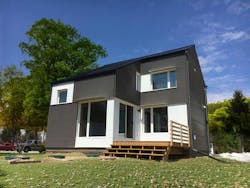New Initiative Enables Builders to Reduce Embodied Carbon
Creating more efficient homes doesn’t just mean they’ll use less energy after they’re built. It also means the homes have a smaller carbon footprint before and as they’re built—by reducing the emissions from all their materials.
This concept, embodied carbon, is one important focus area for RMI, a nonprofit that works to transform energy systems in order to secure a zero-carbon built environment.
“Especially as buildings get more efficient, embodied carbon represents a larger and larger slice of the total emissions a building is responsible for,” says Chris Magwood, manager, carbon-free buildings, RMI. With a well-insulated, airtight, all-electric home, he explains, embodied carbon can account for 80% to 90% of its total lifetime emissions.
To help reduce homes’ upstream greenhouse gas emissions, RMI recently launched HomebuildersCAN—an initiative that helps single-family and low-rise multifamily builders address the often-overlooked climate problem of embodied carbon in home construction. (“CAN” stands for “carbon action network.”) With no membership fee, HomebuildersCAN educates builders, energy raters, and consultants about best practices to identify and mitigate embodied carbon.
“The idea is to bring people together to learn about embodied carbon and understand it collectively, because there’s a lot to figure out in a short amount of time,” Magwood says.
Homebuilding With Reduced Embodied Carbon
On its website, HomebuildersCAN provides a library of case studies detailing how builders have achieved low embodied carbon on specific homes. As a community of practice, HomebuildersCAN offers frequent webinars on topics such as how to procure low-carbon concrete and other innovative materials or how prefab and offsite construction can contribute to low embodied carbon.
HomebuildersCAN also holds in-person conferences. In October, it will join the EEBA (Energy & Environmental Building Alliance) High Performance Home Builder Summit in Salt Lake City.
“There are a lot of pathways into HomebuildersCAN. We want to make everything as open source and easy to access as we can,” Magwood says.
Already, the homebuilding industry has expressed strong interest. About a month after its April launch, HomebuildersCAN boasted about 200 organizational members (construction and consultant companies) and 400 individual members.
“Builders are finding an awful lot of low-hanging fruit at low to no cost,” Magwood says. “We’ve had members already reduce the carbon imprint of the houses they’re building by 25% to 30%.”
How to Reduce Embodied Carbon When Building a Home
How are builders achieving such results? “We have a three-step hierarchy when we think about embodied carbon,” Magwood says:
- First, use less stuff. Put another way: Use only as much material as you need. If a home needs an 8-inch, not 10-inch, concrete wall for its basement, that results in 20% less concrete. Using less stuff also could mean making homes just a bit smaller. A single-family home that has 5% less square footage has 5% less embodied carbon.
- Second, use better versions of the same stuff. For instance, if you currently clad your homes in brick—“by far the highest carbon-footprint material,” Magwood says—then switch it out for a cladding material with a lower carbon footprint.
- And third, use better stuff—the lowest-carbon materials. RMI has found that 70% of a typical new home’s embodied carbon emissions come from just three materials: concrete, insulation, and cladding. “Procurement makes a big difference,” he says.
To understand the embodied carbon of their materials, builders can use a free tool called BEAM (Building Emissions Accounting for Materials). BEAM lists products and their Environmental Product Declarations (EDPs), enabling builders to perform side-by-side comparisons and model homes using various building materials.
While some HomebuildersCAN members make environmental performance part of their marketing strategy, Magwood notes that large, publicly traded builder members also are motivated by current and impending legislation requiring ESG (environmental, social, and governance) disclosures. “Those builders are realizing it’s not unusual for 95% of their total emissions to be from the materials they buy,” he says.
Investors also are playing a role in the growing pressure for builders to understand, disclose, and reduce their homes’ embodied carbon. “A lot of investment companies are making it clear they’re only going to invest when they know the climate impact of a company and the climate risk of its supply chain,” he says.
In addition to supporting builders, RMI and HomebuildersCAN are acting on the policy front. The organization culls input from builders to help influence policy decisions. “Homebuilders can help regulators think about regulating embodied carbon in ways that actually work for the builders,” Magwood says.



